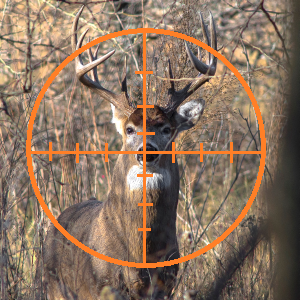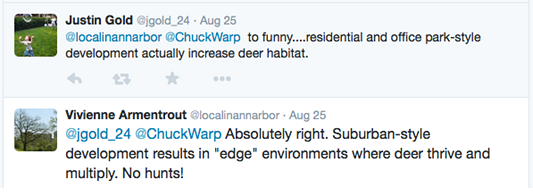The following guest post was written by Wendy Welch, a good friend and also the wife of our very own LOLGOP. Wendy is the marketing director at the Humane Society of Huron Valley (HSHV). Titles in the post are given for identification purposes only and do not indicate support for or endorsement of the views presented.
Enjoy.
 From Lyme disease to the catastrophic destruction of our forests, white-tailed deer are taking the heat for oodles of ills. So beginning this winter, the city of Ann Arbor will be spending tens of thousands of dollars to cull (kill) deer in the city.
From Lyme disease to the catastrophic destruction of our forests, white-tailed deer are taking the heat for oodles of ills. So beginning this winter, the city of Ann Arbor will be spending tens of thousands of dollars to cull (kill) deer in the city.
Sound crazy? It’s true.
Thanks to urban sprawl, declining predators, and our mutual love of the same landscaping, deer and humans aren’t just occasional buddies; we’re next-door neighbors. And some humans aren’t happy about it.
As a member of a pro-cull organization says, “To put it in a nutshell, there simply are too many deer now living happily and successfully in Ann Arbor.”
Another says, “[T]he deer feel very much at home and act as if they own the place.”
“Never saw deer in my neighborhood before last summer. Here it is eating my vegetable garden plants,” writes an upset gardener.
Two 2015 aerial surveys indicate Ann Arbor doesn’t have too many deer (even if surveyors missed counting half the deer, the city is well under the DNR’s healthy herd size). But some homeowner/gardeners have demanded government provide a solution. But not just any solution.
When discussing the solution of relaxing the fencing rules in Ann Arbor, one pro-cull gardener says, “I don’t want to give the city this ‘out.’ I don’t want to have to build a fence around my house or yard.”
Another resident he would like it to go back to rare sightings of deer, “the natural way that was the typical way for decades.”
Never mind that many move to Ann Arbor to enjoy the urban + wild mix (like town + gown), Ann Arbor City Council’s solution is: get out the guns.
To be clear, this isn’t about public health or safety. Though there are myriad misconceptions on Lyme disease, according to the public health department, Washtenaw County doesn’t have any urgent crisis with Lyme disease; and according to the latest science, Lyme isn’t deer’s fault anyway (blame black-footed ticks and white-footed mice).
If safety were the issue, Ann Arbor would be culling bicyclists; motorists in the Tree City have more collisions and injuries with bicycles than with deer. And if Ann Arbor wanted to make the low numbers of deer-vehicle crashes drop even further (they’ve been declining over the past few years), research shows the most cost-effective and effective way to do it is strategic fencing.
So what’s the beef with deer?
“For me,” says City Council Member Chuck Warpehoski, “It is not about saving hostas. For me, the most relevant other concern is the impact on our natural areas.”
Ann Arbor Council Members want to kill deer to save the environment. To be fair, they’re not alone.
The Nature Conservancy says:
In our opinion, no other threat to forested habitats is greater at this point in time — not lack of fire, not habitat conversion, not climate change…We can argue about which threat is more significant than another, but no one who walks the eastern forests today can deny the impact of deer to forest condition.
The Audubon society agrees. Of course, the Audubon society also wants to get rid of outdoor cats: “[Cats] are the top threat to US wildlife.”
Others see grave dangers in cow poop: “[Cow poop is] more damaging to the planet than CO2 from cars.”
Some say, “As far as ecological damage, there is probably not a worse animal [than wild pigs].”
And the exploding Jellyfish population might be too late to stop and “could devastate the global economy.”
The UK has culled badgers. Singapore has culled monkeys. Australia has culled sharks.
And Ann Arbor wants to cull deer. Even though Ann Arbor isn’t the forest the Nature Conservancy describes and Ann Arbor doesn’t have too many deer, Ann Arbor does have some very vocal residents who really, really do not like deer and have been at City Council’s door for 5+ years now.
Like Trump’s 1,954 mile wall between the US and Mexico, culling is … well, dumb. For one, it has to be done ad infinitum (“like mowing a lawn,” the largest culling contractor says). Jackson is on their 9th year of culling. And though shooting 100 deer shows complaining constituents the problem is being “addressed” and provides political cover, it fails to address the underlying issue: Deer love our landscaping as much as we do.
Confronting the increasing number of bird strikes on airplanes, including “Sully” Sullenberger’s 2009 collision on the Hudson River, New York mayor Bloomberg pronounced, “It’s geese or human beings.”
Mass geese culling ensued. City officials reasoned that since nearly 80 percent of geese were residential (not migratory), culls should work. They didn’t.
Ecology is complicated. Single species manipulation is risky business.
In 2006, the USDA culled massive numbers of gulls around Kennedy Airport. Yet bird strikes continued. What happened? Geese moved in. The habitat was perfect for them — an unintended consequence of culling.
In an interview in 2013, Sullenberger said “[T]here is one thing we do know for sure. The most effective thing to prevent these collisions is not to allow anything anywhere near an airport that’s likely to be a bird attractant.”
Until we’re ready to acknowledge how our landscaping is attracting deer and our building on green space is creating more deer habitat — until we take responsibility for the human role in ecology—until we stop taking the quickest, easiest route that doesn’t work in the long-term versus making the effort to do it right — until we see that the one common denominator in all human-wildlife issues is human… well, we’ll continue having issues. Deer this year. Rabbits next. And when will we realize killing doesn’t work? That we can’t turn back time and we need to talk about how best to live with wildlife in modern times?
Having suffered missions of dollars in plane damage from bird strikes, Tel Aviv sought a solution. Tel Aviv University discovered that through understanding migratory movements of birds — by studying their routes, times, altitude — they could predict and reduce bird strikes. And they did. Significantly. Without killing a bird.
The deer issue in Ann Arbor is really a human one. Too bad the deer are the ones who will pay for it.
Deer photo adapated from CC image by Garett Gabriel | Wikimedia Commons]





